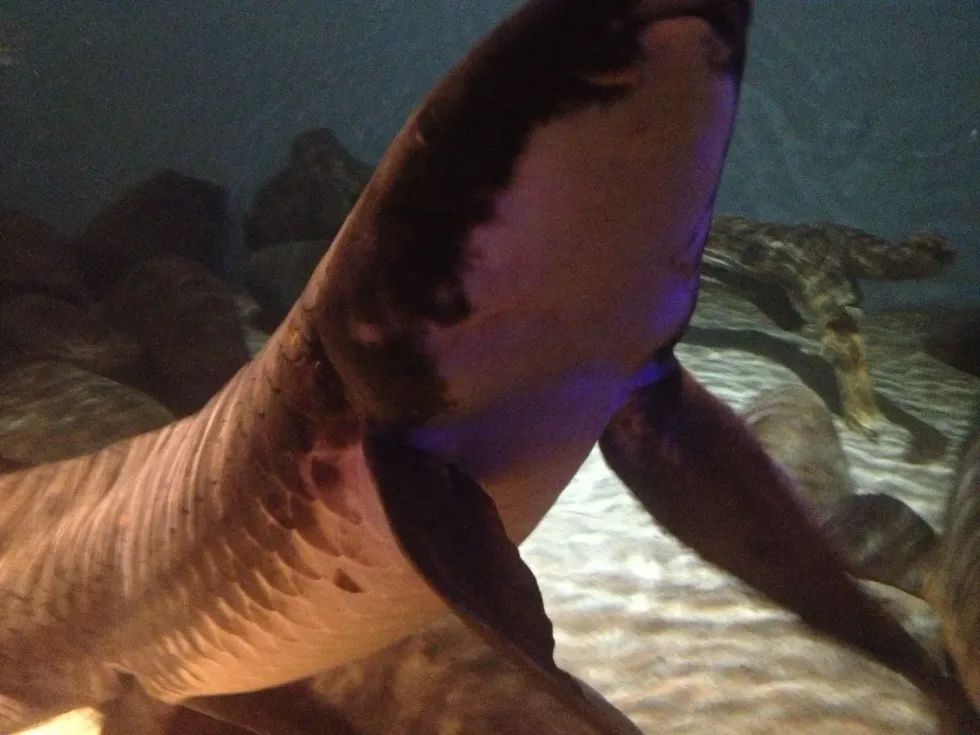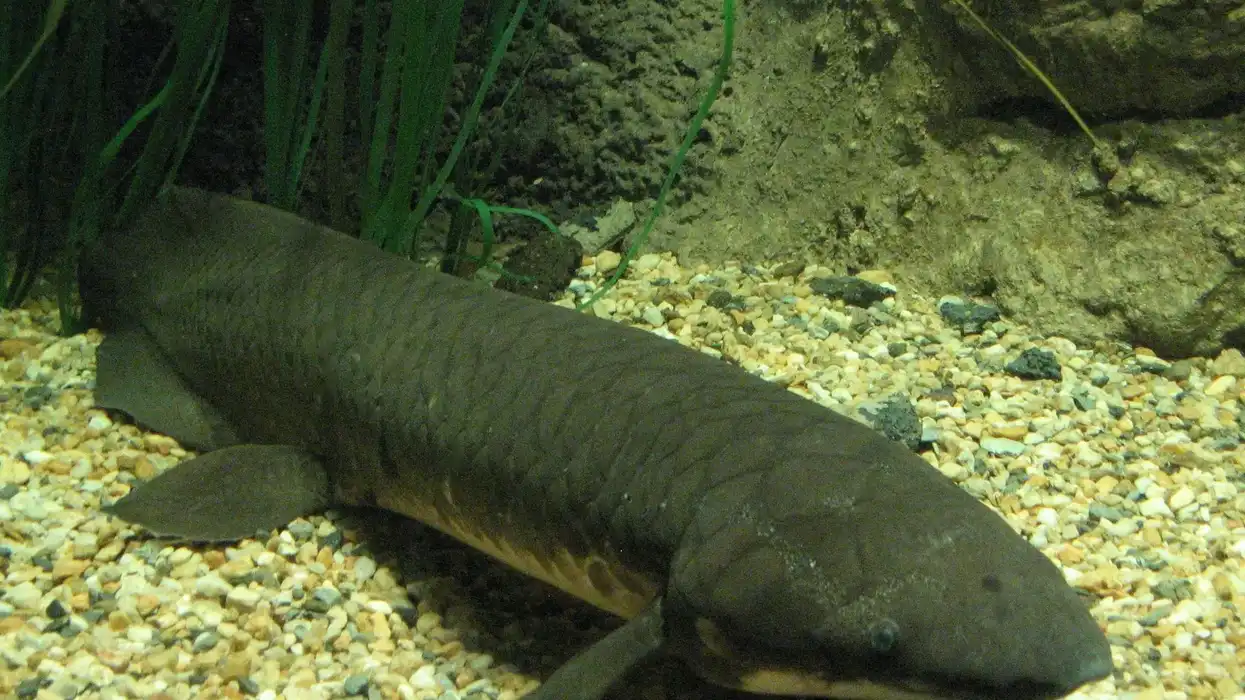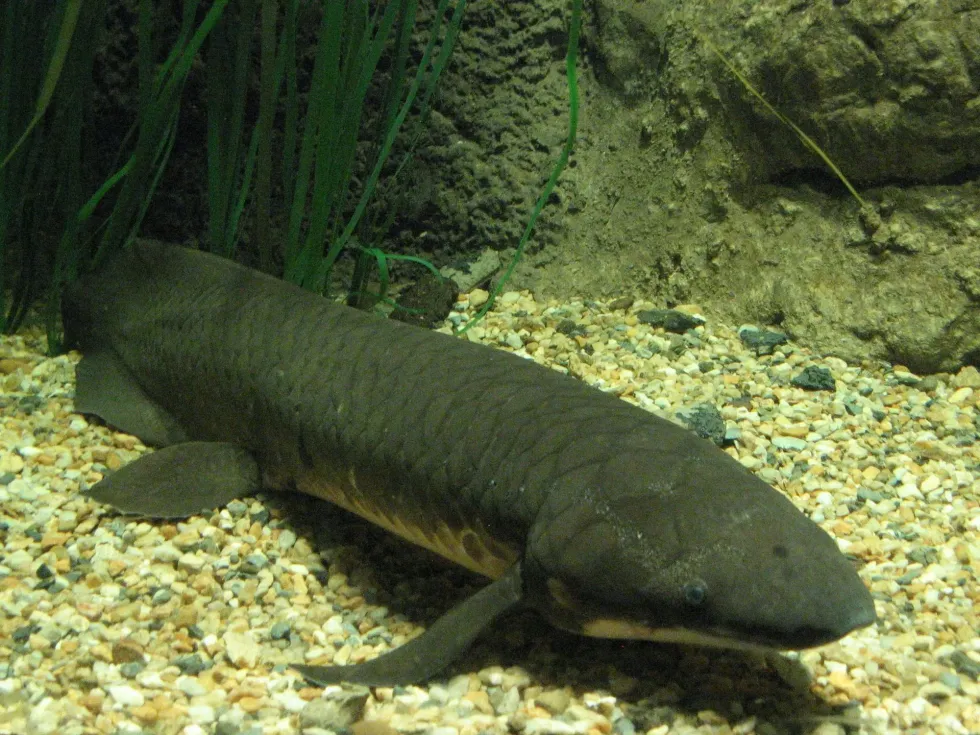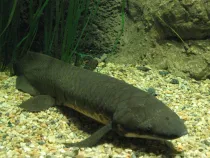Fun Australian Lungfish Facts For Kids

The Australian lungfish, Neoceratodus forsteri (Krefft 1870), is a species of lungfish belonging to the order Dipnoi and family Neoceratodontidae. Air-breathing lungfishes thrived about 413-365 million years ago during the Devonian epoch but currently have been reduced to only six extant species living in Australia, Africa, and South America.
Besides the Australian lungfish, the other five species of lungfish include the South American lungfish (Lepidosiren paradox), gilled lungfish (Protopterus amphibious), marbled lungfish (Protopterus aethiopicus), spotted lungfish (Protopterus dolloi), and the African lungfish (Protopterus annectens).
As evident from its common name, the distribution of the Australian lungfish species is restricted to Australia, particularly in south-eastern Queensland. These fishes are generally found in still waters such as reservoirs and slow-moving river systems with banks of aquatic plants.
Known for their unique breathing mechanism that enables the species to breathe air through their lungs, the Australian lungfishes (and the South American and African lungfishes) are of extreme evolutionary importance and often considered to be a connecting link between fishes and amphibians.
There's more to the interesting biology of the Australian lungfishes. Read on to discover!
If you like what you read, check out interesting facts about the rainbow cichlid and sargo fish.
Australian Lungfish Interesting Facts
What type of animal is an Australian lungfish?
The Australian lungfish (Neoceratodus forsteri) is one of the six extant species of lungfishes native to Australia.
What class of animal does an Australian lungfish belong to?
The Australian lungfishes belong to the class of lobe-finned fishes (class Sarcopterygii).
How many Australian lungfish are there in the world?
No information is available regarding the global population size of the Australian lungfish species.
Where does an Australian lungfish live?
The Australian lungfish species mostly inhabit still water bodies such as reservoirs or slow-flowing river systems with aquatic plants on the banks.
What is an Australian lungfish's habitat?
The Australian lungfish habitat range is primarily restricted to south-eastern Queensland, Australia. The natural distribution of this lungfish species includes the Mary and Burnett rivers.
Besides the Mary and Burnett River systems of south-eastern Queensland, the species were introduced to the Enoggera Reservoir and Brisbane, North Pine, Albert, Condamine, and Coomera rivers to broaden their distribution. While populations in the Enoggera Reservoir, North Pine, and Brisbane rivers thrived, those in the Coomera and Albert rivers have been reduced to small numbers.
The Condamine River population failed to establish.
The species prefers a habitat of slow-moving or still waters with aquatic vegetation on the banks and sand, gravel, or mud at the bottom. They can be found at depths of around 9.8-32.8 ft (3-10 m) and prefer water temperatures in the range of 59-77 F (15-25 C).
Who does Australian lungfish live with?
Members of the species of Australian lungfish mostly live in small groups. Juvenile members of the species have been known to exhibit aggressive and territorial behavior towards other juveniles.
How long does an Australian lungfish live?
The Australian lungfish lifespan can range from 50-100 years.
How do they reproduce?
The Australian lungfish spawns in freshwater systems and displays elaborate pre-mating courtship behavior. These air-breathing lungfishes of Australia spawn in pairs and are very choosy about their spawning sites, particularly depositing their eggs on sand or gravel-rooted aquatic plants in fast or slow-moving waters.
The eggs are mostly deposited as singles and rarely in pairs or in clusters. However, unlike their African or South American cousins, the Australian lungfishes do not make a nest or take special care of their eggs.
The eggs are delicate and encased in a jelly-like envelope, and at a time, about 50-100 eggs are laid, even though the female lungfishes are capable of laying many more eggs.
The lungfishes may spawn both during the day and the night. Initial development of the young lungfish starts while it is still inside the egg and resembles tadpoles when it comes out of the eggs after about three to four weeks.
The young lungfish grows very slowly, reaching a size of only 2.4 in (6 cm) after eight months.
What is their conservation status?
According to a 2019 assessment by the International Union for Conservation of Nature (IUCN) Red List of Threatened Species, the Australian lungfish (Neoceratodus forsteri) is an Endangered species.
Australian Lungfish Fun Facts
What do Australian lungfish look like?
The species of lungfish native to Australia are gray-brown or olive green in color on the fins, tail, sides, and back with an orangish or pale yellow underside. The body of the lungfish is covered with large, bony, overlapping scales that progressively become smaller towards the fins.
The scales overlap to such an extent that some areas of the body are almost four scales thick. The tail is long, powerful, paddle-shaped, and confluent with the caudal, dorsal, and anal fins, somewhat resembling the tail of an eel.
The pectoral fin pair and the pelvic fins are large, flipper-like, and fleshy.
The body is stout and elongated, and the head is flat with small eyes. The male and female lungfish have a similar appearance, except during the breeding season when the male's sides and belly assume a reddish coloring.
Juvenile lungfish look different from adults. The trunk is more slender with a circular head and shorter fins. In addition, juveniles have a mottled appearance and a faint pink underside. Development is marked with gradual bodily changes.

How cute are they?
Australian lungfishes cannot really be considered cute for the simple reason that they do not have any distinct physical feature that would be conventionally regarded as adorable or particularly striking. The lungfish is quite inactive and sluggish and will mostly exist as an unresponsive and quiet creature by day.
How do they communicate?
The lungfish breathes noisily, making loud sounds that are thought to be a sort of mating call. Besides, the eyes of the lungfish are equipped with specialized cells that improve the animal's color vision and the ability to differentiate between objects based on color.
Apart from their visual abilities, Australian lungfishes are quick at detecting vibrations and electric fields produced by other animals, which aid the fish in survival and hunting.
How big is an Australian lungfish?
The Australian lungfish size can go up to 4.9 ft (1.4 m), even though the average length may be 3.3 ft (1 m). They are almost of the same size as that of the West African lungfish.
How fast can an Australian lungfish swim?
No information is available regarding the swimming speed of the lungfish. However, they are quite inactive and sluggish animals that spend most of the day lounging quietly and being unresponsive. The strong flipper-like tail helps the fish in rapid escape movements.
How much does an Australian lungfish weigh?
The Australian lungfish can weigh up to 95 lb (43 kg), even though the average for the species is about 44 lb (20 kg).
What are the male and female names of the species?
Male and female lungfishes do not have any distinct names.
What would you call a baby Australian lungfish?
Baby lungfishes may be called larvae or juveniles.
What do they eat?
The Australian lungfishes are carnivorous and consume a diet consisting of fishes, amphibians, insects, terrestrial worms, mollusks, and aquatic crustaceans. There is a change in diet as these fish develop from the juvenile stage to adults, perhaps due to a change in their dentition.
When the lungfish are young, they have sharp conical teeth and primarily feed on small crustaceans like shrimps and worms.
Are they aggressive?
The Australian lungfish is a primarily sedentary and lazy animal that moves around at night and returns to a specific area for rest and recovery during the day. However, juveniles are quite territorial and, unlike the calm adults, exhibit aggressive behavior towards other juveniles.
In fact, young fish that are relatively larger in size have been observed to bite and shove smaller individuals in an attempt to take over ideal habitats. The lungfish is not known to be aggressive towards humans.
Would they make a good pet?
Australian lungfishes are predatory carnivores and can get quite aggressive towards other aquatic animals.
Hence, they are not quite suited as pets. Besides, the Queensland Fisheries Act, 1994 protects the species from fishing, and it requires a special permit to collect this lungfish for relevant purposes such as research, aquaculture, and educational display.
In addition, this lungfish is a nationally threatened species as per the EPBC Act which means that it is offensive to take any action that will have a significant and detrimental impact on the survival of the lungfish.
Did you know...
The lungfish native to Australia has a single dorsal lung, an exception from other species of lungfish that possess two lungs. Moreover, it is the only extant species of lungfish that can breathe through its gills. The single lung is only used when the water becomes muddy or scarce in oxygen or when the fish is very active.
While the African lungfish can survive in a habitat that is entirely depleted of water, the Australian lungfish can live for several days out of the water as long as it is kept moist in aquatic weeds or in the bottom mud.
Ceratodus, a small settlement in Queensland, Australia, gets its name from the Australian lungfish (Neoceratodus forsteri).
Fossil remains of the Australian lungfish dating back to more than 100 million years ago have been uncovered from New South Wales. These lungfish are regarded as living fossils, making them an important resource for studying the evolutionary biology of all land vertebrates.
Fossil records of the group to which the lungfish belong date back to around 380 million years ago when the higher classes of vertebrates were only beginning to evolve.
Known predators of the Australian lungfish are the jewfish and the Australian wood ducks.
Naming the Australian lungfish
The Australian lungfish is also known by other common names such as the Queensland lungfish, barramunda, and Burnett salmon. The species name of the Queensland lungfish (Neoceratodus forsteri) honors the British politician and pastoral squatter William Forster.
What is special about lungfish?
A unique aspect of the lungfish is that it has a well-developed respiratory system with two lungs. While most other fish species breathe air through simple, modified gas bladders, the lungfish have lungs subdivided into numerous small air sacs to increase the surface area for gaseous exchange.
Moreover, their lungs are joined to the pharynx and larynx without a trachea. Their gills are too underdeveloped to allow the adequate exchange of gases.
Here at Kidadl, we have carefully created lots of interesting family-friendly animal facts for everyone to discover! For more relatable content, check out these devilfish facts and candiru facts for kids.
You can even occupy yourself at home by coloring in one of our free printable Australian lungfish coloring pages.
We Want Your Photos!
More for You
See All
Bachelor of Arts specializing in Journalism and Mass Communication, Postgraduate Diploma in Sports Management

Moumita DuttaBachelor of Arts specializing in Journalism and Mass Communication, Postgraduate Diploma in Sports Management
A content writer and editor with a passion for sports, Moumita has honed her skills in producing compelling match reports and stories about sporting heroes. She holds a degree in Journalism and Mass Communication from the Indian Institute of Social Welfare and Business Management, Calcutta University, alongside a postgraduate diploma in Sports Management.
Postgraduate Diploma in Management

Sakshi RaturiPostgraduate Diploma in Management
Sakshi has experience in marketing strategy, social media planning, and recruiting industry experts for capstone projects, she has displayed a commitment to enhancing their skills and knowledge. She has won multiple awards, including a Certificate of Appreciation for Creative Writing and a Certificate of Merit for Immaculate Turut, and is always seeking new opportunities to grow and develop.
Disclaimer
1) Kidadl is independent and to make our service free to you the reader we are supported by advertising. We hope you love our recommendations for products and services! What we suggest is selected independently by the Kidadl team. If you purchase using the Buy Now button we may earn a small commission. This does not influence our choices. Prices are correct and items are available at the time the article was published but we cannot guarantee that on the time of reading. Please note that Kidadl is a participant in the Amazon Services LLC Associates Program, an affiliate advertising program designed to provide a means for sites to earn advertising fees by advertising and linking to Amazon. We also link to other websites, but are not responsible for their content.
2) At Kidadl, we strive to recommend the very best activities and events. We will always aim to give you accurate information at the date of publication - however, information does change, so it’s important you do your own research, double-check and make the decision that is right for your family. We recognise that not all activities and ideas are appropriate for all children and families or in all circumstances. Our recommended activities are based on age but these are a guide. We recommend that these ideas are used as inspiration, that ideas are undertaken with appropriate adult supervision, and that each adult uses their own discretion and knowledge of their children to consider the safety and suitability. Kidadl cannot accept liability for the execution of these ideas, and parental supervision is advised at all times, as safety is paramount. Anyone using the information provided by Kidadl does so at their own risk and we can not accept liability if things go wrong.
3) Because we are an educational resource, we have quotes and facts about a range of historical and modern figures. We do not endorse the actions of or rhetoric of all the people included in these collections, but we think they are important for growing minds to learn about under the guidance of parents or guardians.







